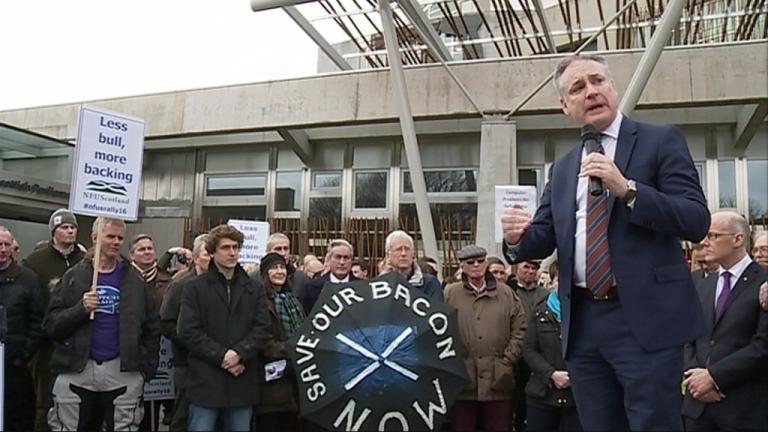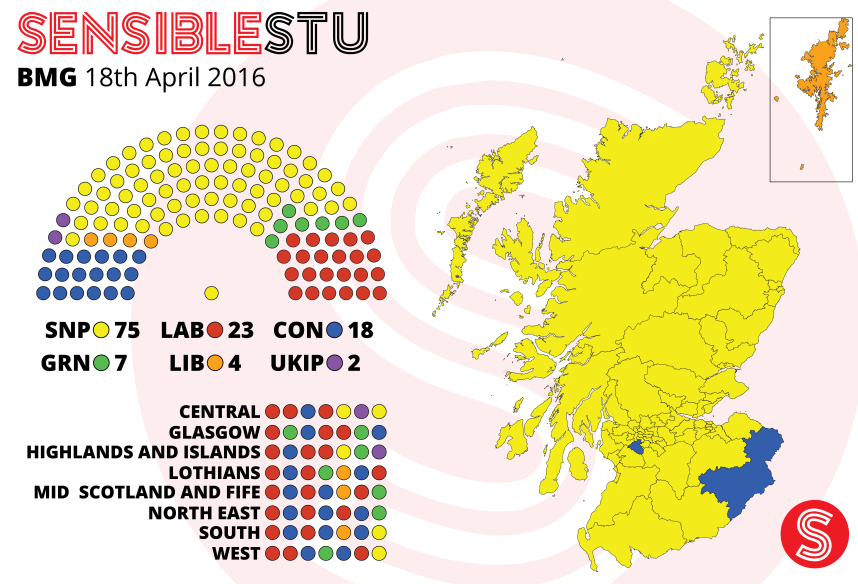What would Scotland’s political landscape look like under STV?
Last night, my dear friend James MacKenzie suggested that the next Scottish Parliament elections will be fought using Single Transferable Vote (STV), because the SNP, Greens, and Lib Dems all (apparently) support it and the Scottish Parliament now has the power to change it. While I think that is absolute rubbish (why would a politician as risk-averse as Nicola Sturgeon pursue electoral reform that wasn’t in anyone’s manifesto?) I began to speculate as to what that would look like. So I set about putting together multi-member STV constituencies for the Scottish Parliament.
My first assumption is that, as local government in Scotland uses wards of either three or four seats that these would also be the predominant model used for Parliament seats too. However, any reform effort would doubtless come under significant pressure to include the possibility of five seat constituencies too, in order to prevent a systematic bias in favour of large parties. I’m also assuming that there will be 129 seats, on the basis that electoral reform would be an almost impossible sell if it simultaneously includes creating more politicians. It seems obvious to exclude three seats for the islands, though I’m avoiding the question of how you’d represent these three disparate areas under STV. That leaves 126 seats to be made up on the mainland. I have sought to follow the rules set out in the Scotland Act 1998, which are summarised as follows:
- So far as is practicable, regard must be had to the boundaries of the local government areas.
- The electorate of a constituency must be as near the electoral quota as is practicable, having regard to Rule 1.
- Rules 1 and 2 may be departed from where special geographical considerations (including in particular the size, shape and accessibility of a constituency) render it desirable to do so.
- Regard must be had for the inconveniences attendant on alterations of constituencies and of any local ties which would be broken by such alterations.
I also commenced the way the Boundary Commission for Scotland usually does, which is to start at the top and work my way down. The electorate data is from the last review of UK Parliament constituencies (which was not completed), so it’s a little dated. Nonetheless, it provides a relatively good indication of how it can be done.
The total electorate for the mainland is 3,873,387, making the quota for three, four, and five seat constituencies 92,224, 122,965, and 153,706, respectively. The proposed constituencies are as follows.
As the electorate data is broken down into wards, some of the divisions are a little clunky. This is particularly the case where the cities are concerned and wards have electorates in excess of 20,000 voters.
A handful of constituencies were particularly difficult to make up. One such example is Argyll and Bute – a seat that is not in the Highlands, but neither is it suburban Glasgow. It was difficult to put together a seat for Argyll that wasn’t vastly under the quota or vastly over the quota, and there appears to be very little that can be done at the fringes to avoid this (i.e. you either include Dumbarton, or you don’t). East and Mid Lothian is also considerably over quota, which could be more easily resolved by transferring some electors from Millerhill, Craighall, or Musselburgh into Edinburgh.
Geographically, the seats would look as follows:
How would #sp16 have panned out under this system?
It’s obviously impossible to accurately translate results from one electoral system into another. What this simply amounts to is educated guesswork – the factors involved are the constituency votes in the relevant existing constituencies, the strength of the parties’ list vote in the broader region, and guesstimates as to how transfers might pan out. In a good chunk of the seats this is a relatively easy task (for example, in Dumfries and Galloway, the vote share across the two equivalent constituencies amounted to two quotas for the Tories, one for the SNP, and one for Labour, while the Greens performed poorly in the south list relative to the rest of Scotland). However, in many others, I’m simply going on instinct. In those instances, the results are a good deal less than scientific. Finally, I’m assuming that, whatever way they were elected, the three island seats would have produced the same three MSPs.
Therefore, if the Scottish Parliament election had been held using STV on the above boundaries, my guess is…
SNP: 64, Conservatives: 28, Labour: 27, Lib Dems: 6, Greens: 4.
If you want to give it a go yourself, the full breakdown of my guesswork is available here.

 The SNP have spent decades slowly winning the support of Scotland’s farming communities. Though historically a solidly Tory demographic, the SNP first started making serious inroads in Scotland’s most agrarian areas in the 1980s, in particular in the North East. In the decades that followed their dominance in rural Scotland became increasingly apparent: they won Angus East, Banff and Buchan, and Moray in 1987; the Perth and Kinross by-election in 1995; and padded their numbers still by winning Galloway and Upper Nithsdale, and Tayside North in 1997. That dominance wasn’t just reflected in election results, either. The SNP’s support in rural communities, and their relationship with farmers, was visible in their ever-present stalls at agricultural shows, as well as the increasing number of giant “Vote SNP” hoardings on the roadsides, where once they would have said “Conservative and Unionist.” However, that relationship has severely soured in the past few months.
The SNP have spent decades slowly winning the support of Scotland’s farming communities. Though historically a solidly Tory demographic, the SNP first started making serious inroads in Scotland’s most agrarian areas in the 1980s, in particular in the North East. In the decades that followed their dominance in rural Scotland became increasingly apparent: they won Angus East, Banff and Buchan, and Moray in 1987; the Perth and Kinross by-election in 1995; and padded their numbers still by winning Galloway and Upper Nithsdale, and Tayside North in 1997. That dominance wasn’t just reflected in election results, either. The SNP’s support in rural communities, and their relationship with farmers, was visible in their ever-present stalls at agricultural shows, as well as the increasing number of giant “Vote SNP” hoardings on the roadsides, where once they would have said “Conservative and Unionist.” However, that relationship has severely soured in the past few months.